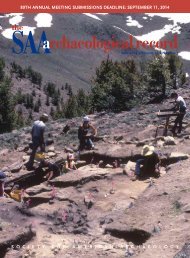SAA
SAA_Record_Nov2015
SAA_Record_Nov2015
You also want an ePaper? Increase the reach of your titles
YUMPU automatically turns print PDFs into web optimized ePapers that Google loves.
PROS AND CONS OF CONSULTING COLLECTORS<br />
AVOCATIONAL ARCHAEOLOGISTS AND THE<br />
DESIGNATION OF A WORLD HERITAGE SITE<br />
Robert Connolly<br />
Robert Connolly is Associate Professor in the Department of Anthropology at the University of Memphis, Tennessee.<br />
This past spring, I participated in a forum about professional<br />
archaeologists working with amateur or avocational<br />
archaeologists. The session, “Cons or Pros:<br />
Should Archaeologists Collaborate with Responsible Collectors?”<br />
was organized by Michael Shott and Bonnie Pitblado<br />
at the Society for American Archaeology Annual Meeting<br />
held in San Francisco. In their introductory comments, both<br />
organizers emphasized the need for a cordial and respectful<br />
discussion, perhaps anticipating a polarized response to the<br />
question they posed. I have a long-standing concern with the<br />
dismissive view taken by many professionals in our discipline<br />
of all amateur or avocational archaeologists, whether<br />
they collect artifacts or not. During a graduate school lecture<br />
I listened to a professor state, “There is no such thing as an<br />
amateur archaeologist. Would you go to an amateur brain<br />
surgeon?” At that time, my response was something like<br />
“You have got to be kidding. Give me a break!”<br />
Over the past 50 years, as our discipline has become more<br />
professionalized with degreed practitioners from highereducation<br />
institutions, the separation between the avocational<br />
and professional archaeologist has increased. The sentiment<br />
of my graduate school professor is not uncommon in<br />
our discipline. Today, the role of the avocational archaeologist<br />
is viewed not as different from but as decidedly less than<br />
that of the professional.<br />
In this essay, I review the contributions of a few seminal avocational<br />
archaeologists at the Poverty Point earthworks<br />
(16WC1) in northeast Louisiana. I show how that role has<br />
decreased over the past 50 years. I also demonstrate how the<br />
work of avocational archaeologists proved critical in the<br />
recent UNESCO World Heritage designation of the site. I<br />
argue that without greater public engagement, including<br />
engagement with avocational archaeologists, our discipline<br />
will have a decreased value to the public that pays our<br />
salaries. I do not take a “holier than thou” position on this<br />
issue. I acknowledge my hesitancy to commit time and<br />
resources to substantive avocational engagement during my<br />
tenure as the Station Archaeologist at the Poverty Point site<br />
and elsewhere. I use the term “avocational” to mean someone<br />
without professional training who makes their living by<br />
other means but expends a good bit of time, energy, and<br />
research on archaeology as a second unpaid career or heavily<br />
invests in it as a hobby. Some avocational archaeologists collect<br />
or have collected artifacts, others do not. All are critical<br />
to the advancement of the field of archaeology.<br />
The Modern Discovery of the Poverty Point Site<br />
Like most prehistoric monumental architecture recorded in<br />
the modern era, Poverty Point (Figure 1) was discovered by<br />
explorers, adventurers, and antiquarians. One of the earliest<br />
written accounts describing the site is by Samuel Lockett in<br />
the 1870s, although an earlier unpublished autobiography of<br />
Jacob Walters describes his visit to the area around 1840<br />
(Connolly 1997). The first detailed map of the earthen<br />
mounds at Poverty Point was made by C. B. Moore (1913)<br />
based on investigations conducted during the winter of<br />
1912–1913. Moore was also the first to provide detailed<br />
descriptions and illustrations of cultural materials recovered<br />
from the site.<br />
Clarence Webb and Carl Alexander,<br />
Surface Collectors Extraordinaire<br />
Clarence Webb, a pediatrician and avocational archaeologist<br />
from Shreveport, Louisiana, is arguably the best link and<br />
source of continuity between the 1950s Poverty Point culture<br />
investigations of James Ford and those initiated by Jon Gibson<br />
in the 1970s and continued by others to this day. His initial<br />
contact with Ford was in 1936 at the Belcher Mounds that<br />
Webb was investigating (Gibson 1992:11).<br />
By the 1970s, Webb, with apparently a good bit of free time<br />
from his career as a pediatrician, had typed over 100,000 arti-<br />
20 The <strong>SAA</strong> Archaeological Record • November 2015




